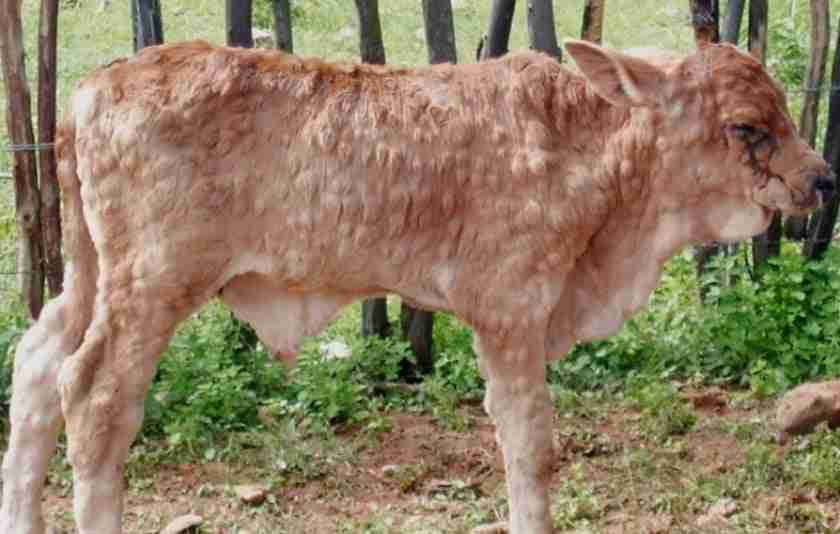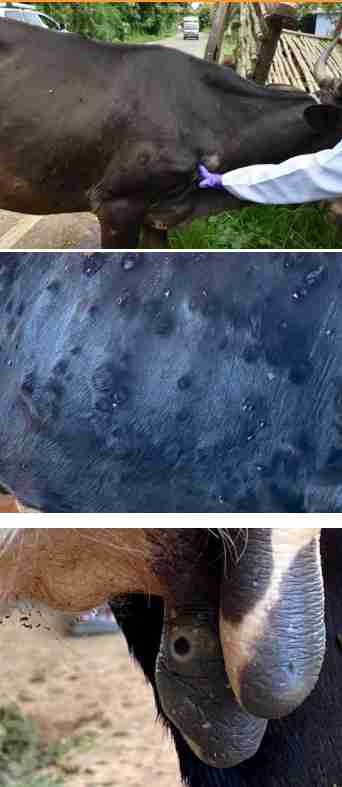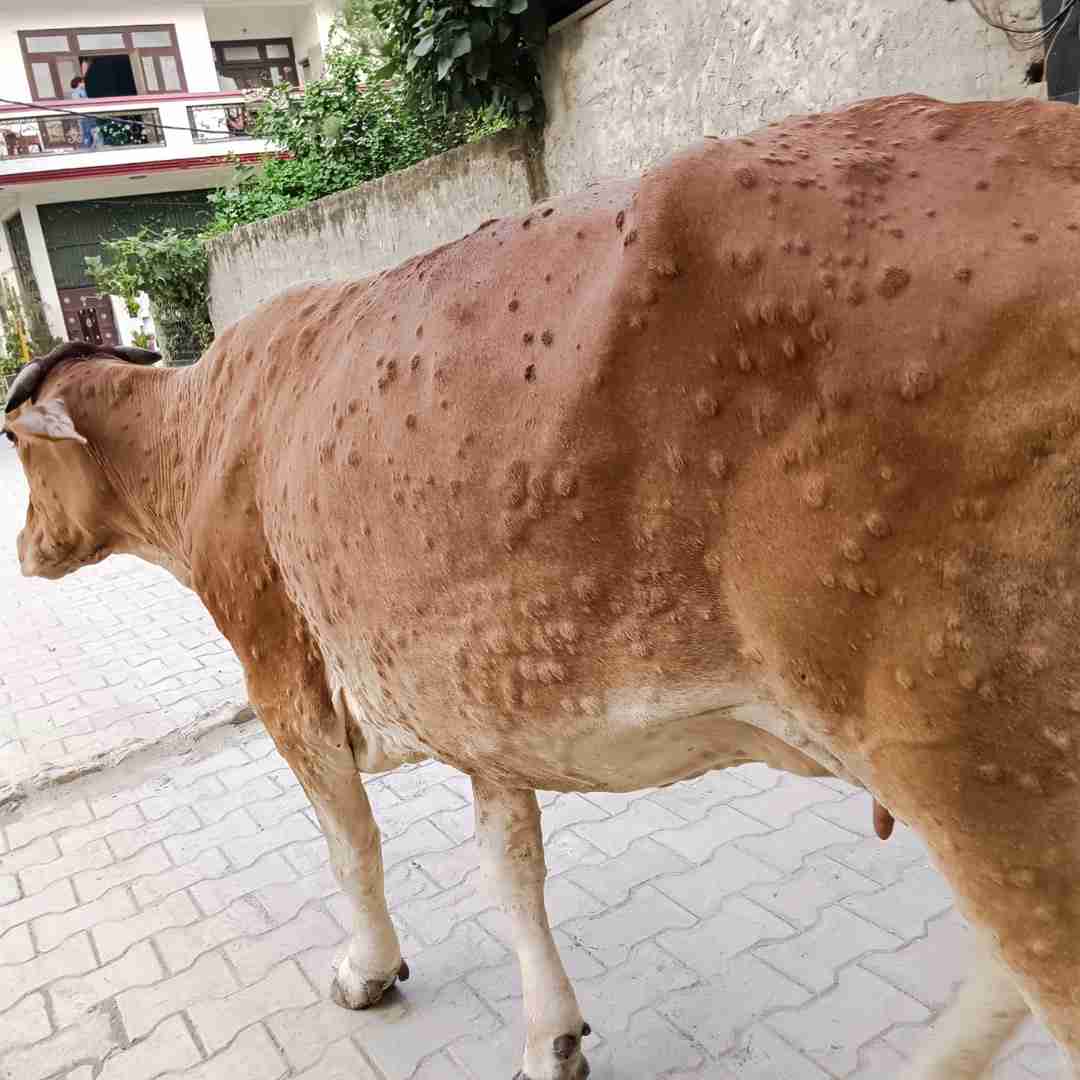Lumpy skin disease (LSD) is a viral disease that affects cattle and can also affect water buffalo, yaks, and bovine species. It is caused by a virus in the Poxviridae family and is transmitted through direct contact with infected animals or through the bites of certain insects, such as flies and mosquitoes.

LSD is characterized by the formation of large, raised bumps (or “lumps”) on the skin, which can be accompanied by fever, weight loss, and reduced milk production. The bumps can also affect the animal’s respiratory and nervous systems, causing breathing difficulties and neurological symptoms.
There is no specific treatment for LSD, and the disease can be severe or even fatal in some cases. Control measures include vaccination, quarantine of infected animals, and vector control to reduce the transmission of the virus through insect bites. It is important to promptly diagnose and isolate infected animals to prevent the spread of the disease to other animals.
Why does Lumpy skin disease happen?
Lumpy skin disease (LSD) is caused by a virus in the Poxviridae family called Capripoxvirus. It is transmitted through direct contact with infected animals or through the bites of certain insects, such as flies and mosquitoes.
LSD can affect cattle, water buffalo, yaks, and other bovine species. The virus infects the skin and mucous membranes of the animal, causing the formation of large, raised bumps (or “lumps”) on the skin. These bumps can be accompanied by fever, weight loss, and reduced milk production.
In addition to the skin, the virus can also affect the animal’s respiratory and nervous systems, causing breathing difficulties and neurological symptoms. The disease can be severe or even fatal in some cases.

What are the symptoms of Lumpy skin disease?
The symptoms of lumpy skin disease (LSD) can vary depending on the severity of the infection and the age and health of the animal. Common symptoms of LSD include:
- Large, raised bumps (or “lumps”) on the skin: These bumps can be firm to the touch and are typically found on the head, neck, and upper body of the animal.
- Fever: Many animals with LSD develop a fever as their body’s immune system tries to fight off the infection.
- Weight loss: The virus can affect the animal’s appetite, leading to weight loss.
- Reduced milk production: In lactating animals, the virus can cause a reduction in milk production.
- Breathing difficulties: The virus can also affect the respiratory system, causing breathing difficulties in some animals.
- Neurological symptoms: Some animals with LSD may develop neurological symptoms, such as difficulty walking or standing, tremors, or difficulty swallowing.
It is important to promptly diagnose and isolate infected animals to prevent the spread of the disease to other animals. Control measures include vaccination, quarantine of infected animals, and vector control to reduce the transmission of the virus through insect bites.
What is the cause of Lumpy skin disease?
Lumpy skin disease (LSD) is caused by a virus in the Poxviridae family called Capripoxvirus. The virus infects the skin and mucous membranes of the animal, causing the formation of large, raised bumps (or “lumps”) on the skin. These bumps can be accompanied by fever, weight loss, and reduced milk production. In addition to the skin, the virus can also affect the animal’s respiratory and nervous systems, causing breathing difficulties and neurological symptoms.
LSD is transmitted through direct contact with infected animals or through the bites of certain insects, such as flies and mosquitoes. The disease can affect cattle, water buffalo, yaks, and other bovine species. It is important to promptly diagnose and isolate infected animals to prevent the spread of the disease to other animals. Control measures include vaccination, quarantine of infected animals, and vector control to reduce the transmission of the virus through insect bites.
What is the Treatment for Lumpy skin disease?
There is no specific treatment for lumpy skin disease (LSD) in cattle, Buffalo, Cow, sheep, Goat, and dairy animals. Treatment is typically supportive, and may involve the following measures:
- Isolation of infected animals: It is important to isolate infected animals to prevent the spread of the disease to other animals.
- Fluid therapy: Animals with LSD may be dehydrated due to the fever and reduced appetite associated with the disease. Fluid therapy can help to rehydrate the animal and maintain electrolyte balance.
- Nutritional support: Animals with LSD may have a reduced appetite, so providing them with high-quality feed can help them maintain their nutritional status.
- Antipyretics: Nonsteroidal anti-inflammatory drugs (NSAIDs) may be used to reduce fever and inflammation associated with the disease.
- Antibiotics: Antibiotics may be used to treat or prevent secondary infections.
- Respiratory support: Animals with severe respiratory symptoms may require oxygen therapy and/or mechanical ventilation.
It is important to promptly diagnose and isolate infected animals to prevent the spread of the disease to other animals. Control measures include vaccination, quarantine of infected animals, and vector control to reduce the transmission of the virus through insect bites.
What is the Homeopathy treatment for Lumpy skin disease?
There is no scientific evidence to support the use of homeopathy for the treatment of lumpy skin disease (LSD). LSD is a viral disease that requires medical treatment and management by a veterinarian.
Homeopathy is a system of alternative medicine that is based on the principle of “like cures like,” and is based on the belief that diluted substances can cause similar symptoms in a healthy person as the illness being treated. There is no scientific basis for this principle, and homeopathy has not been proven to be effective for the treatment of any medical condition.
It is important to seek the advice of a veterinarian for the treatment of LSD. Treatment typically involves supportive measures such as the isolation of infected animals, fluid therapy, nutritional support, antipyretics, and antibiotics to treat or prevent secondary infections. In severe cases, respiratory support may be necessary.
Control measures for LSD include vaccination, quarantine of infected animals, and vector control to reduce the transmission of the virus through insect bites. It is important to follow the guidance of a veterinarian and implement recommended control measures to prevent the spread of the disease.
Precautions against Lumpy skin disease
It is important to exercise caution when caring for animals with lumpy skin disease (LSD). LSD is a viral disease that can affect cattle and other bovine species, and it is transmitted through direct contact with infected animals or through the bites of certain insects, such as flies and mosquitoes.
Here are some important precautions to take when dealing with animals with LSD:
- Wear protective clothing: When handling infected animals, it is important to wear protective clothing such as gloves and a mask to prevent exposure to the virus.
- Isolate infected animals: It is important to isolate infected animals to prevent the spread of the disease to other animals.
- Follow quarantine and movement restrictions: It is important to follow quarantine and movement restrictions put in place by authorities to prevent the spread of the disease.
- Implement vector control measures: Vector control measures such as insect control can help to reduce the transmission of the virus through insect bites.
- Follow the guidance of a veterinarian: It is important to follow the guidance of a veterinarian and implement recommended control measures to prevent the spread of the disease.
It is important to promptly diagnose and isolate infected animals to prevent the spread of LSD to other animals. Control measures include vaccination, quarantine of infected animals, and vector control to reduce the transmission of the virus through insect bites.
Prevention of Lumpy skin disease
There are several measures that can be taken to prevent the spread of lumpy skin disease (LSD):
- Vaccination: A vaccine is available for the prevention of LSD in cattle. Vaccination is an effective way to prevent the disease and should be considered as part of a control program.
- Quarantine: Infected animals should be quarantined to prevent the spread of the disease to other animals.
- Movement restrictions: The movement of animals should be restricted to prevent the spread of the disease. This may include measures such as limiting the movement of animals from infected areas or requiring animals to be tested and certified as free from the disease before movement.
- Vector control: Vector control measures such as insect control can help to reduce the transmission of the virus through insect bites.
- Good hygiene practices: Good hygiene practices, such as frequent cleaning and disinfection of equipment and facilities, can help to prevent the spread of the disease.
It is important to follow the guidance of a veterinarian and implement recommended control measures to prevent the spread of LSD.

Lumpy skin disease vaccine
A vaccine is available for the prevention of lumpy skin disease (LSD) in cattle. The vaccine is made from a modified live virus that is attenuated (weakened) so that it cannot cause the disease. When the vaccine is administered, the animal’s immune system is stimulated to produce antibodies against the virus, providing protection against LSD.
The vaccine is typically administered by subcutaneous injection, and a booster dose may be required to maintain immunity. The vaccine is generally well-tolerated, with few side effects reported.
Vaccination is an effective way to prevent LSD and should be considered as part of a control program. It is important to follow the guidance of a veterinarian regarding the use of the vaccine, including the recommended vaccination schedule and booster intervals.
In addition to vaccination, other control measures for LSD include quarantine of infected animals, movement restrictions, vector control, and good hygiene practices. It is important to follow the guidance of a veterinarian and implement recommended control measures to prevent the spread of the disease.
Can Lumpy skin disease in Humans?
Lumpy skin disease (LSD) is a viral disease that affects cattle and can also affect water buffalo, yaks, and other bovine species. The virus that causes LSD is not known to cause illness in humans.
Human infection with the LSD virus is not known to occur. LSD is transmitted through direct contact with infected animals or through the bites of certain insects, such as flies and mosquitoes. There is no evidence to suggest that the virus can be transmitted from animals to humans or from humans to animals.
It is important to exercise caution when handling infected animals and to follow recommended control measures to prevent the spread of LSD to other animals. These measures include vaccination, quarantine of infected animals, movement restrictions, vector control, and good hygiene practices. It is important to follow the guidance of a veterinarian and implement recommended control measures to prevent the spread of the disease.
Lumpy skin disease history in the world
LSD has been known to affect cattle for centuries, with the first recorded outbreaks occurring in Africa and Asia. The disease was first described in the scientific literature in the early 20th century. It has since spread to other parts of the world, including Europe, the Middle East, and South America.
LSD is transmitted through direct contact with infected animals or through the bites of certain insects, such as flies and mosquitoes. The disease can have a significant economic impact on affected farms and livestock industries, as it can cause significant morbidity and mortality in animals and can result in reduced milk production, weight loss, and trade restrictions.
Control measures for LSD include vaccination, quarantine of infected animals, movement restrictions, vector control, and good hygiene practices. It is important to follow the guidance of a veterinarian and implement recommended control measures to prevent the spread of the disease.
Lumpy skin disease FAQ
Q1. What is the cause of lumpy skin disease?
Ans. Lumpy skin disease (LSD) is caused by a virus in the Poxviridae family called Capripoxvirus. The virus infects the skin and mucous membranes of the animal, causing the formation of large, raised bumps (or “lumps”) on the skin.
Q2. How is lumpy skin disease treated?
Ans. There is no specific treatment for lumpy skin disease (LSD) in cattle, Buffalo, Cow, sheep, Goat, and dairy animals. Treatment is typically supportive, and may involve the following measures:
Isolation of infected animals: It is important to isolate infected animals to prevent the spread of the disease to other animals.
Fluid therapy: Animals with LSD may be dehydrated due to the fever and reduced appetite associated with the disease. Fluid therapy can help to rehydrate the animal and maintain electrolyte balance.
Q3. Is lumpy skin disease fatal?
Ans. In severe cases, LSD can be fatal. The virus can cause fever, weight loss, reduced milk production, and skin lesions that can lead to secondary infections. In severe cases, the virus can also affect the respiratory and nervous systems, leading to respiratory distress and neurological symptoms.
Q4. How long does lumpy skin disease last?
Ans. The duration of lumpy skin disease (LSD) can vary depending on the strain of the virus, the age and health of the animal, and the presence of other underlying conditions.
In general, the clinical signs of LSD typically last for 2 to 4 weeks. During this time, the animal may have a fever, weight loss, reduced milk production, and skin lesions. In severe cases, the virus can affect the respiratory and nervous systems, leading to respiratory distress and neurological symptoms.
After the initial clinical signs resolve, the animal may continue to shed the virus in their milk and nasal secretions for several weeks or months. The animal may also continue to have skin lesions for several weeks or months after the initial infection.
Q5. Is lumpy skin disease in Australia?
Ans. In Australia, LSD has been detected in cattle in Queensland, New South Wales, and Victoria. The disease has also been detected in other parts of the world, including Africa, Asia, Europe, the Middle East, and South America.
Q6. How is lumpy skin spread?
Ans. The virus that causes LSD is transmitted through direct contact with infected animals or through the bites of certain insects, such as flies and mosquitoes.
LSD is highly contagious and can spread rapidly in areas where there is a high density of cattle or other bovine species. The virus can be shed in the animal’s milk, nasal secretions, and other body fluids, and it can be transmitted through contact with these fluids or through the bites of infected insects.
Q7. Is there a vaccine for lumpy skin disease?
Ans. Yes, there is a vaccine available for the prevention of lumpy skin disease (LSD) in cattle. The vaccine is made from a modified live virus that is attenuated (weakened) so that it cannot cause the disease. When the vaccine is administered, the animal’s immune system is stimulated to produce antibodies against the virus, providing protection against LSD.
Q8. Can lumpy skin disease affect dogs?
Ans. The virus that causes LSD is not known to cause illness in dogs or other non-bovine species.
LSD is transmitted through direct contact with infected animals or through the bites of certain insects, such as flies and mosquitoes. There is no evidence to suggest that the virus can be transmitted from animals to dogs or from dogs to animals.
While LSD is not known to affect dogs, it is important to exercise caution when handling infected animals and to follow recommended control measures to prevent the spread of LSD to other animals. These measures include vaccination, quarantine of infected animals, movement restrictions, vector control, and good hygiene practices. It is important to follow the guidance of a veterinarian and implement recommended control measures to prevent the spread of the disease.










